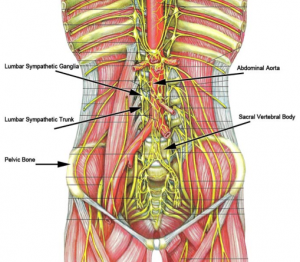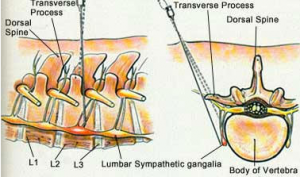WHAT IS A LUMBAR SYMPATHETIC BLOCK?
This is a procedure that is used to relieve the pain in the lower extremities due to reflex sympathetic dystrophy (RSD), which is also known as complex regional pain syndrome (CRPS). Additional painful conditions that can benefit include phantom limb pain, herpes zoster (shingles) pain, cancer pain, and pelvic pain at times. It also helps relieve circulatory symptoms from vasospastic disease of the legs and peripheral vascular disease that is not operable.
RSD is a condition characterized by over activity of the sympathetic nerves producing severe pain and temperature changes. A lot of the time, narcotic medications, physical therapy, and chiropractic treatment can help reduce the pain, but are not effective at “breaking the cycle” of sympathetic nerve over activity.
The same problem may occur with sympathetic nerve over activity causing blood vessels to constrict, leading to decreased blood flow to the leg and resulting pain. It can almost feel like a tourniquet has been applied to the leg on a continual basis from the sympathetic nerves firing out of control.
So the premise behind the lumbar sympathetic block is to stop the over activity of the nerves. This may “break the cycle” that has been perpetuating the problem and eliminate the pain and other symptoms that have resulted.
WHAT EXACTLY IS THE LUMBAR SYMPATHETIC CHAIN?

The lumbar sympathetic chain (trunk) lays just next to the lumbar spine on either side.
The lumbar sympathetic chain is a collection of nerve fibers running along the front and side of the lumbar vertebrae usually around L2 through L4. Sympathetic nerves are part of the autonomic nervous system, which performs functions that people don’t have to think about. This would include how much to dilate or constrict blood vessels to regulate appropriate flow to the legs, gastrointestinal movement, heart rate, sexual arousal, etc.
At times a sympathetic nerve may be stimulated due to an injury or other trauma to the body. It may be from a car accident, or a knee surgery, or a simple slip and fall injury. In this situation, the sympathetic nerves become over active and cause the blood vessels in the leg to constrict and remain constricted, which then results in poor circulation to the leg. Pain and possibly swelling, unusual color of the skin and temperature changes in the limb, skin and nail changes can result. By performing a sympathetic nerve block, the blood vessels dilate, circulation is improved and pain relief may then result.
FOR WHAT CONDITIONS IS A LUMBAR SYMPATHETIC BLOCK EFFECTIVE?
The Lumbar Sympathetic Block works well for lower extremity pain from:
- Reflex Sympathetic Dystrophy (RSD)
- Complex Regional Pain Syndrome (CRSP)
- Phantom Limb Pain
- Herpes Zoster Pain (shingles)
- Cancer Pain
- Lower Extremity Vasospastic Disorder
- Inoperable Peripheral Vascular Disease
- Some types of pelvic pain
Call (602) 507 – 6550 to schedule your Appointment TODAY!

How is the procedure performed?
The pain management doctor will have you lay on your stomach for the procedure and may use IV sedation, but it is not absolutely necessary. Your skin will sterilized, and the soft tissue numbed through the superficial and deeper soft tissues.
Fluoroscopy (real time x-ray) is used to position the needle on the side of the lumbar sympathetic chain for symptoms and once needle position is close contrast dye is injected  to confirm accuracy. At that point numbing medicine is injected, and possibly a neurolytic agent such as phenol to provide longer lasting symptom relief.
to confirm accuracy. At that point numbing medicine is injected, and possibly a neurolytic agent such as phenol to provide longer lasting symptom relief.
All in all, the procedure takes about 15 minutes. After the procedure, your vital signs will be monitored for a while prior to being discharged.
HOW WELL DOES A LUMBAR SYMPATHETIC NERVE BLOCK PROCEDURE WORK?
Right away patients will typically notice increased temperature in the leg and the veins feel “full”. This is normal and means the block was positioned correctly. A temperature increase of 2 degrees Celsius denotes successful block.
Sympathetic blocks have been shown to be an excellent pain relieving procedure for those suffering from RSD and CRPS (Manjunath et al, 2008). In patients who have these conditions, oral pain medications are not always very helpful for relieving pain.
With lumbar sympathetic blocks, pain doctors will often use phenol to provide relief or a radiofrequency ablation. The patient may require repeat injections regularly as pain relief may be achieved anywhere from a few weeks to over a year.
WHAT ARE THE RISKS OF A LUMBAR SYMPATHETIC BLOCK?
The risks of a lumbar sympathetic block are low. There is a low risk of infection, bleeding, nerve damage, or a collapsed lung (pneumothorax). There may be an allergic reaction to one of the medications used.
With the numbing agents used, there may be some numbness of the legs and motor deficits that are usually temporary.
If you suffer from any of the above conditions such as CRPS or RSD, call Arizona Pain Specialistst today. The clinics have Board Certified, Award Winning pain doctors with expertise in the management of these complicated conditions.
Modern, effective pain management for a sympathetic over activity syndrome does not have one “silver bullet” treatment. That is why treatment with a comprehensive Arizona pain management center will provide the best pain relief, and that is what Arizona Pain Specialists is!
Call (602) 507 – 6550 to schedule your Appointment TODAY!

![]()



 to confirm accuracy. At that point numbing medicine is injected, and possibly a neurolytic agent such as phenol to provide longer lasting symptom relief.
to confirm accuracy. At that point numbing medicine is injected, and possibly a neurolytic agent such as phenol to provide longer lasting symptom relief.